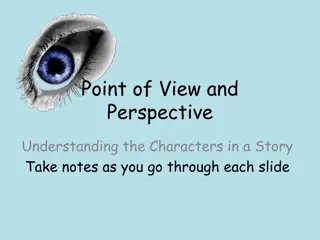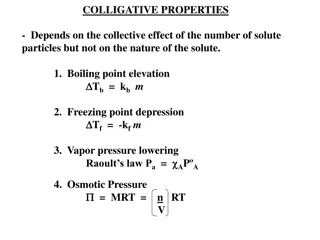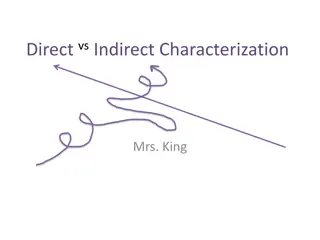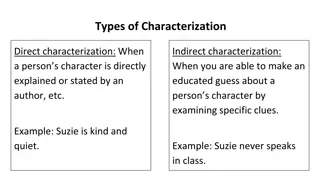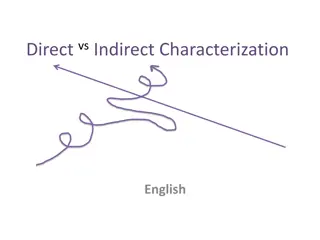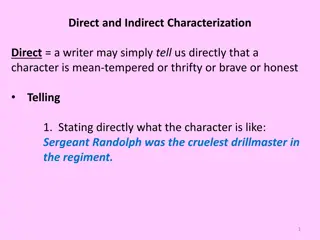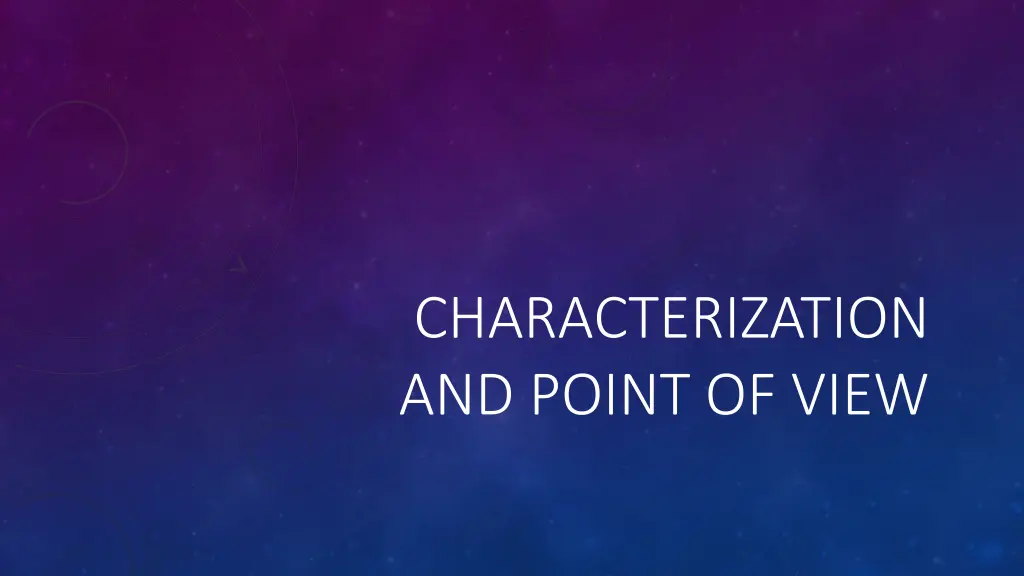
Exploring Characterization Techniques in Literature
Discover the art of revealing character through authorial interpretation, appearance, action, speech, and thought in literature. Examples from renowned authors illustrate these techniques vividly.
Download Presentation

Please find below an Image/Link to download the presentation.
The content on the website is provided AS IS for your information and personal use only. It may not be sold, licensed, or shared on other websites without obtaining consent from the author. If you encounter any issues during the download, it is possible that the publisher has removed the file from their server.
You are allowed to download the files provided on this website for personal or commercial use, subject to the condition that they are used lawfully. All files are the property of their respective owners.
The content on the website is provided AS IS for your information and personal use only. It may not be sold, licensed, or shared on other websites without obtaining consent from the author.
E N D
Presentation Transcript
CHARACTERIZATION AND POINT OF VIEW
WAYS TO CHARACTERIZE Burroway discusses five ways to reveal character: Authorial interpretation Appearance Action Speech Thought
EXAMPLE OF AUTHORIAL INTERPRETATION: Mrs Touchett was by no means without benevolence, [but] rarely succeeded in giving an impression of softness. Henry James EXAMPLES OF CHARACTERIZATION THROUGH APPEARANCE: My grandmother wore four skirts; one supported the next, and she wore the lot of them in accordance with a definite system, that is, the order of the skirts was changed from day to day Gunter Grass Helen comes in a chauffeured car. She is all cream and roses. Her stockings are purest silk; her underskirt, just briefly showing, is lined with lace. Fay Weldon
EXAMPLES OF CHARACTERIZATION THROUGH ACTION: Missie May kept on crying and Joe not knowing what to do with all his feelings, he put Slemmon s watch charm in his pants pocket and took a good laugh and went to bed. Zora Neale Hurston Then I heard, very close to me, a footstep and a cough. I felt my flesh get hard you know that feeling but I didn t look up from my book, although I felt that I was being watched. John Cheever
EXAMPLES OF CHARACTERIZATION THROUGH SPEECH: A character who says It is indeed a pleasure to meet you is very different from one who says, Hey, man, what it is? Burroway, p. 138 Now, the cleverest thing of the sort that I ever did was inventing a new pudding during the meat course. Lewis Carroll I have a lousy trip to Philadelphia, lousy flight back, I watch my own plane blow a tire on closed-circuit TV, I go to my office, I find Suzy in tears Joan Didion
SPEECH CAN BE.. Summarized: Carefully, playing down the danger, Len filled her in on the events of the long night. Burroway, p. 137 Reported indirectly: Had he brought the coffee? She had been waiting all day long for coffee. Gosh, no, he hadn t. Lord, now he d have to go back. Katherine Anne Porter Quoted directly: What is it you re after then? Who was this person you re investigating?
EXAMPLES OF CHARACTERIZATION THROUGH THOUGHT: Like speech, a character s thought can be offered in three ways. Summarized: He hated the way she ate. Burroway Reported indirectly: It was all very well if the Seversons wanted to let their cats run loose, but she certainly wasn t responsible for Lisbeth s parakeets, now was she? Burroway Quoted directly: How I envy her! Miss Doheny thought. How fortunate she is to find herself in these easy times, not condemned because she loves a man! --William Trevor Burroway notes that interesting effects can be achieved when a character s thoughts (aka internal dialog) contradict his or her speech.
POINTS OF VIEW There are three basic points of view: Third person: She walked out into the harsh sunlight. A third person author can be omniscient know everything or limited know only what the character knows. Second person: You walked out into the harsh sunlight. This quirky style basically turns the reader into your character. First person: I walked out into the harsh sunlight. First person narrators seem very intimate, but first person narrators can be reliable or unreliable.
POETIC SPEAKER Every poem has a speaker. Usually the speaker is the poet: Two roads diverged in a wood, and I I took the one less traveled by, And that has made all the difference. --Robert Frost Sometimes the poem dramatizes another person, as in this poem about Eve: Of course she never was a child herself waking as she did one morning full grown and perfect, with only Adam, another innocent, to love her and instruct --Linda Pastan
Sometimes the poems speaker is an inanimate object or an animal, like this poem from the point of view of a pig: It s wonderful how I jog on four honed-down ivory toes my massive buttocks slipping like oiled parts with each light step... --Philip Levine Poems, like prose, can be written from first, second, or third-person point of view.



